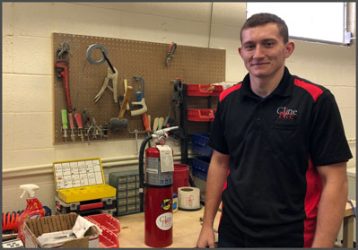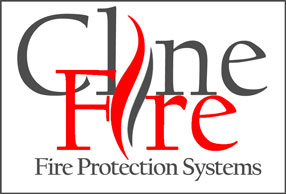Fire Extinguishers & Emergency Lights
Portable fire extinguishers and exit/egress lighting (e-lights) are an important part of your facility’s fire and life safety plan. Fire extinguishers provide a reliable means to extinguish a small fire before it spreads or, in a more serious fire situation, a means to extinguish a path through a fire to safety, while e-lights illuminate during an emergency or power-outage event.
Most facilities require fire extinguishers to be spaced no more than 50ft-75ft apart (depending on the building occupancy and construction type, in accordance with NFPA 10, NFPA 101) and e-lights to be located accordingly to illuminate safe pathways of travel throughout the facility.

Fire Extinguishers
These are the types of fire extinguishers and the fires they are effective against.
Extinguisher Type – Fire Fuel Source
Class A
paper, wood, textiles, plastics
Class B
liquid (e.g., cooking liquids, oil, gasoline, kerosene, paint)
Class C
electrical in nature
Class K
cooking appliance fires (required as part of a pre-engineered “hood” suppression system)
Class D
heated metals
Clean Agent
various (used in areas where powder extinguishers would damage or incapacitate the equipment or assets being protected)
According to NFPA 10 Standard for Portable Fire Extinguishers adopted by the State of Ohio’s fire code, fire extinguishers are required to be inspected monthly, serviced annually, and have maintenance performed every six years. The monthly inspection can be performed by facility staff; however, the annual service and periodic maintenance needs to be performed by a certified individual working for a certified organization.
Emergency Lights (e-lights)
E-light Type – Use
Exit Lights
located throughout emergency exit paths to clearly identify designated pathways during an emergency with the word “EXIT” marked in bright red letters
Egress Lights
brightly illuminate exit pathways during an emergency power-outage situation
Combo Lights
incorporate the components of an exit light and an egress light into a single appliance
E-lights are required to undergo an annual 90-minute-load test to ensure that the appliances, bulbs, and back-up batteries are prepared to operate for a full 90 minutes during a power-outage event.

